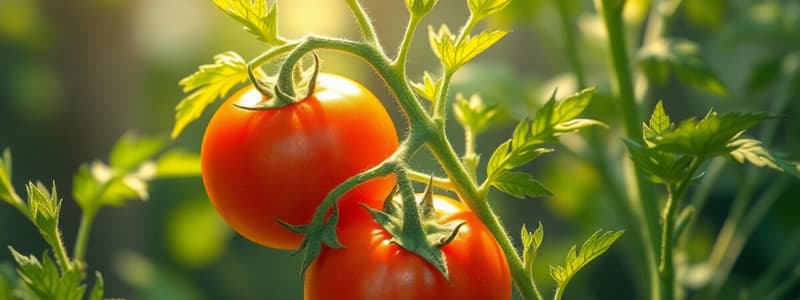Podcast
Questions and Answers
What is the independent variable in the experiment regarding tomato plants?
What is the independent variable in the experiment regarding tomato plants?
Which variable is affected by the amount of sunlight in this experiment?
Which variable is affected by the amount of sunlight in this experiment?
Which of the following best describes a hypothesis?
Which of the following best describes a hypothesis?
What should a conclusion of an experiment include?
What should a conclusion of an experiment include?
Signup and view all the answers
What is the role of controlled variables in an experiment?
What is the role of controlled variables in an experiment?
Signup and view all the answers
What step comes after performing the experiment in the scientific method?
What step comes after performing the experiment in the scientific method?
Signup and view all the answers
Which of the following is NOT a control variable in the tomato plant experiment?
Which of the following is NOT a control variable in the tomato plant experiment?
Signup and view all the answers
Why is it important to communicate the results of an experiment?
Why is it important to communicate the results of an experiment?
Signup and view all the answers
What was Mia's hypothesis regarding the tomato plants?
What was Mia's hypothesis regarding the tomato plants?
Signup and view all the answers
What was the condition of the tomato plants in Pot C after the week?
What was the condition of the tomato plants in Pot C after the week?
Signup and view all the answers
Which pot received the most water during Mia's experiment?
Which pot received the most water during Mia's experiment?
Signup and view all the answers
What is the primary characteristic of qualitative observations?
What is the primary characteristic of qualitative observations?
Signup and view all the answers
How did Mr. Cruz respond to Mia's presentation of her findings?
How did Mr. Cruz respond to Mia's presentation of her findings?
Signup and view all the answers
Which step in the scientific method did Mia exemplify when she labeled her tomato plants?
Which step in the scientific method did Mia exemplify when she labeled her tomato plants?
Signup and view all the answers
What does quantitative observation involve?
What does quantitative observation involve?
Signup and view all the answers
What type of question generally initiates a scientific investigation?
What type of question generally initiates a scientific investigation?
Signup and view all the answers
Study Notes
Hypothesis Formulation
- A hypothesis is an educated guess or a tentative answer to a posed question.
- Typically structured in an "if-then" format for clarity and focus.
Experiment Design
- An experiment consists of tests to verify the hypothesis.
- Involves manipulating and measuring variables:
- Independent Variable: The amount of sunlight the tomato plant receives.
- Dependent Variable: The number of fruits produced by the tomato plant.
- Controlled Variables: Factors that remain constant, including water amount, soil type, plant variety, and pot size.
Results Recording and Analysis
- Gathering and reporting data is essential to interpret the outcome of the experiment.
- Data includes information collected throughout the experimentation process.
Conclusion Drawing
- A conclusion summarizes the experimental results and assesses the validity of the hypothesis.
- If the hypothesis holds true, it addresses the problem posed; if not, revisiting the experiment or altering the methodology is necessary.
Communication of Results
- Sharing findings from the experiment with others, highlighting the importance of clear communication in scientific discovery.
Case Study: Mia and the Tomato Plants
- Mia, a seventh-grader, noticed health variations among her tomato plants and hypothesized that water quantity affected plant health.
- Conducted an experiment with three pots, each receiving different water amounts:
- Pot A: Half a cup of water daily
- Pot B: One cup of water daily
- Pot C: No water
- Observed results over a week:
- Pot B plants thrived, Pot A showed moderate growth, and Pot C wilted.
- Concluded that adequate watering leads to healthier tomato plants, impressing her teacher with her findings.
Types of Observations
- Qualitative Observations: Data gathered through senses, reflecting subjective experiences without numerical values (e.g., plant vitality).
- Quantitative Observations: Objective data collected through measurement (e.g., growth height, water volume).
Observation in Context
- Tomatoes in sunlight yielded more fruits compared to those in shaded areas, underscoring the importance of sunlight for optimal plant growth.
Studying That Suits You
Use AI to generate personalized quizzes and flashcards to suit your learning preferences.
Description
This quiz explores the relationship between sunlight and the fruit production of tomato plants. Participants will formulate a hypothesis regarding how sunlight impacts tomato plant yield. Test your understanding of plant biology and the scientific method!


